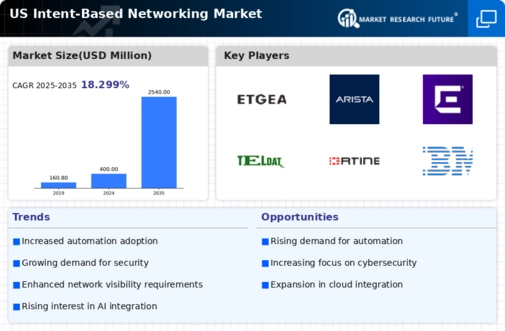Rising Demand for Network Efficiency
The intent based-networking market is experiencing a notable surge in demand for enhanced network efficiency. Organizations are increasingly seeking solutions that optimize their network performance while minimizing operational costs. This trend is driven by the need for seamless connectivity and the ability to manage complex network environments. According to recent data, companies that implement intent based networking solutions report up to a 30% reduction in network downtime, which directly correlates with improved productivity. As businesses continue to expand their digital footprint, the intent based-networking market is poised to grow, with projections indicating a compound annual growth rate (CAGR) of approximately 25% over the next five years. This growth reflects a broader shift towards more agile and responsive network infrastructures.
Emergence of IoT and Connected Devices
The proliferation of Internet of Things (IoT) devices is a key driver for the intent based-networking market. As the number of connected devices continues to rise, organizations face challenges in managing and securing their networks. Intent based networking offers a solution by providing automated and intelligent management of these devices, ensuring optimal performance and security. Current estimates suggest that there will be over 75 billion connected devices by 2025, creating a substantial demand for networking solutions that can handle this complexity. The intent based-networking market is likely to benefit from this trend, as businesses seek to implement robust networking strategies that can accommodate the growing IoT landscape.
Need for Enhanced Network Security Posture
The intent based-networking market is increasingly driven by the need for enhanced network security posture among organizations. With cyber threats becoming more sophisticated, businesses are prioritizing security in their networking strategies. Intent based networking provides advanced security features, such as automated threat detection and response, which are essential for protecting sensitive data. Recent studies indicate that organizations utilizing intent based networking solutions experience a 50% reduction in security incidents. This heightened focus on security is likely to propel the growth of the intent based-networking market, as companies invest in technologies that not only enhance performance but also fortify their defenses against cyber threats.
Increased Focus on Data Privacy Regulations
The intent based-networking market is significantly influenced by the evolving landscape of data privacy regulations in the US. With the implementation of stringent laws such as the California Consumer Privacy Act (CCPA), organizations are compelled to adopt networking solutions that ensure compliance while safeguarding sensitive information. This regulatory environment creates a pressing need for intent based networking technologies that can dynamically adapt to changing compliance requirements. Companies are investing in these solutions to mitigate risks associated with data breaches, which can cost upwards of $3.86 million on average per incident. As a result, the intent based-networking market is likely to see accelerated growth as businesses prioritize compliance and data protection.
Shift Towards Cloud-Based Networking Solutions
The intent based-networking market is witnessing a significant shift towards cloud-based networking solutions. As organizations increasingly migrate their operations to the cloud, there is a growing demand for networking technologies that can seamlessly integrate with cloud environments. This transition is driven by the need for scalability, flexibility, and cost-effectiveness. Research indicates that cloud-based networking solutions can reduce infrastructure costs by as much as 40%, making them an attractive option for businesses. Furthermore, the ability to leverage intent based networking in cloud environments enhances operational efficiency and enables real-time decision-making. Consequently, this trend is expected to propel the growth of the intent based-networking market as more companies adopt cloud-first strategies.





















Leave a Comment